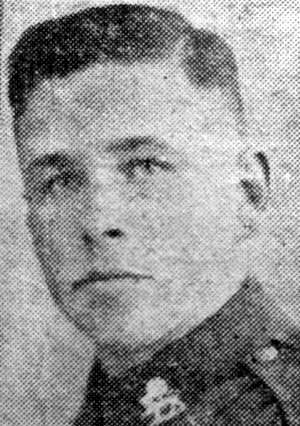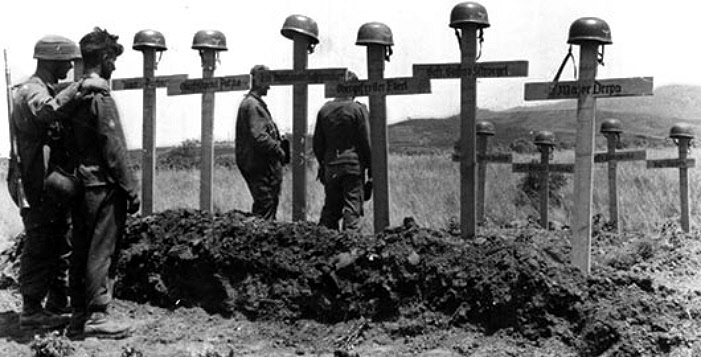
Clarence Kilburn was born in Spring 1914 in Dewsbury, the son of blanket raiser, Edwin Kilburn and his wife Ellen (formerly Brown, nee Collins), who were married at All Saints Church, Dewsbury on the 22nd September 1913. Both bridegroom and bride, a widow, were 23 years of age and living respectively at 10 and 12 Cossham Road, Dewsbury.
Clarence had three sisters: Margaret, born in 1917; Daisy, born in 1919, and Annie, born in 1920, just a few months before their father, Edwin Kilburn died, at the early age of 30 years, in Dewsbury. Clarence Kilburn’s twice widowed mother, Ellen, aged 31 years, married 39 year-old salesman William Owen at St. Philip’s Church, Dewsbury on the 13th October 1921. Both were then living at 67, Old Bank, Dewsbury.
Clarence Kilburn joined the 2nd Battalion, York and Lancaster Regiment circa 1935 as a regular soldier. At the out break of the Second World War, the 2nd Battalion, York and Lancaster Regiment was based in Khartoum in the Sudan on garrison duties.
In July 1940, they were moved to Egypt, and then to Palestine, where they became part of the 14th Infantry Brigade. The battalion was again part of the 6th Infantry Division. In May 1940 the 14th Infantry Brigade moved to Cairo and was then broken up. The 2nd Battalion, York and Lancasters went to Alexandria, Egypt. The battalion, now on loan to the Royal Navy was moved to Crete in the cruiser HMS Ajax, arriving at Suda Bay, Crete on the 2nd November 1940. Their arrival was met by an attack from the Italian Air Force. The 14th Infantry Brigade was reformed around the 2nd Battalion, Yorks and Lancs and the 2nd Battalion, Black Watch. The reformed brigade spent its time building defenses on the island, but these were limited. Little happened on Crete until April 1941 when the Allied forces in Greece were evacuated.
With the surrender of Greece in 1941 Crete was thrust into the war. The 2nd Battalion, Yorks and Lancs along with the 2nd Battalion, Black Watch and 2nd Battalion, The Leicestershire Regiment were tasked with the defence of Heraklion airfield. From the middle of May 1941, air attacks against Heraklion increased to four or five a day, but the RAF 33 Squadron had been withdrawn from the island on the 19th May, so there was no air defence other than AA batteries. On the 20th May 1941, troop carriers dropped German paratroopers at Maleme airfield on the west of the island.
Warning reached Heraklion as their own share of German Ju52 troop transports were spotted arriving at a height of about 400 feet, four abreast, in long columns that stretched out of sight. This was the largest of the German parachute formations made up of the 1st Fallschirmjager Regiment, 2nd Battalion from the 2nd Fallschirmjager Regiment and an AA Machine Gun Battalion under the command of Col. Bruno Brauer.
The three battalions of the 14th Brigade managed to kill or wound nearly all the German parachute troops that were landed at Heraklion on in this first wave, apart from a small pocket, the brigade had inflicted massive casualties on the enemy paratroopers.
From the “War Diary” of the 2nd Battalion, York and Lancaster Regiment:
“In a matter of seconds the air was full of parachutes slowly descending to the ground. The moment the Battalion had waited for had come. Intense small-arms fire caused very heavy casualties among the enemy. Of those who escaped death in the air, the majority were killed on the ground, before they had time to get clear of their harness, by small parties of men rushing from their slit trenches with bayonets and bombs. The tanks and carriers also came out of their hiding-places and massacred all those who landed in the open.
On the Battalion front outside the perimeter opposite “B” Company, one large group of enemy landed in an area occupied by some Greek troops. “B” Company promptly attacked and spent a couple of hours in rather confused fighting in some very enclosed country. They killed a number of the enemy and then left the Greeks to carry out the final mopping-up. Meanwhile, well inside the perimeter another body of enemy had collected in a small village. “C” Company, which was in reserve, put in an immediate counter-attack and dealt with them well and truly before they had time to get properly organized. Some eighty of the enemy were killed for the loss of about five casualties. The rest of the Battalion was not so heavily involved but dealt with everything that fell in its area, even the Quartermaster, Lieutenant Armstrong, taking part and for the expenditure of one round, accounting for the only paratrooper who had the temerity to try and invade his store.
The enemy fared no better at the hands of the other units of the garrison. Of about 1,000 enemy troops who had come down inside the perimeter, over 900 of them had been buried by noon the next day. Small parties and odd individuals of course escaped, but these were mopped up during the next few days. Quite a large force, however, had fallen clear of the perimeter and parties of them were heard calling to each other after dark; they made no attempt to attack, being possibly too shaken by what had happened to their comrades. Thus the day ended in complete victory for the Heraklion garrison and the total failure of the Germans to achieve their object of capturing the aerodrome by direct airborne attack.”
For their invasion of Crete, the German forces undertook the largest parachute operation of the war thus far, and over 9,500 airborne paratroops landed, with around 7,000 killed.

After this attempt the Germans did not try to land any more paratroopers at Heraklion, and instead they built up their forces outside the perimeter. The German forces now had control of the airfield at Maleme and this gave them the advantage they needed after their heavy losses earlier. They landed four more companies of troops in the vicinity of Heraklion which successfully linked up with the survivors of the first landings and launched counterattacks on the British positions. Before the Germans were able to complete the encirclement of Heraklion a company from the 1st Battalion, Argyll and Sutherland Highlanders joined the defence from Tymbaki on the south coast. The Germans were continually probing against the defences and the following is the last serious fighting in which the battalion took part before their evacuation from the island.
“When it was reported that the enemy on the front of “B” Company appeared to be withdrawing, a battalion attack was hastily organized by Lieutenant-Colonel Gilroy to accelerate their departure. This was carried out on a two-company front with “B” company on the right and “A” Company on the left, whilst a company of the Leicesters under command was in reserve. Two light tanks were also attached for the operation. The advance was over very enclosed country, consisting of a mass of small houses and gardens. The field of fire was nowhere more than fifty yards.
All went well for about eight hundred yards, as the enemy fell back without offering much resistance. Then both tanks dropped out as their machine gun locks broke and there were no spares. Soon after this “A” and “B” Companies were held up by very heavy automatic fire. from this it appeared that the enemy was now on the line he intended to hold. Every corner and turning seemed to be covered by fire and it was almost impossible to pick out the enemy posts in the thick and enclosed country.
The reserve company was put in to turn the left flank, but it found it strongly held and suffered considerable casualties. As there was a danger of the enemy infiltrating at night and getting through the gap which the advance had left in the perimeter, the attack was called off and all companies withdrew to their original positions. Whilst commanding “A” Company during the attack, Captain Tucker was very severely wounded.”
It is likely that Private Clarence Kilburn was killed in action during the battalion attack detailed above, again taken from the “War Diary” of the 2nd Battalion, York and Lancaster Regiment.
The fighting at this time was extremely fierce but the Yorks and Lancs held their positions. By the 28th May 1941, the position on the island as a whole had been lost and General Freyberg ordered the evacuation. When the men of the 14th Brigade heard of the evacuation they were astonished. To them, the whole battle of the last ten days had seemed to have been eminently successful.
The “Ossett Observer” had this short obituary for Clarence Kilburn:1
“Ossett Soldier Killed – On May 25th last, it was officially reported that Clarence Kilburn, son of Mrs. E. Owen, 62a, Dewsbury Road, Streetside, Ossett, and of the late Mr. Edwin Kilburn, was reported missing. No further news was received concerning him until a few days ago, when a letter was received from his platoon sergeant, which seems to leave no doubt that he was killed in action.
The letter, which is dated November 17th 1941, states: ‘Dear Friend – I address you as dear friend because your son, who was a very great friend of mine for five or six years. I am sending you this letter so that you will know that I was with your son when he got killed. I must express my sympathy with you. I know it is very hard to lose anyone, but believe me when I say your son died a very gallant death. I know it seems hard to say it, but I don’t think he felt it. I suppose you wonder who I am? I was his platoon sergeant, and I know that he was a good man and a good soldier. I am sure that you will miss him, and I ask you to accept my sincere sympathy.’
Clarence Kilburn, who was 26 years of age, was a native of Dewsbury, but resided in Ossett for thirteen years, and prior to joining the Army, worked at Walton Colliery. He served in the York and Lancaster Regiment and six years ago was posted to the Middle East. He was a keen and skilful boxer, and won the championship of his barracks the year before he went abroad.”
Clarence Kilburn died on the 2st May 1941, aged 27 years, and is remembered on Face 7 of the Athens Memorial. The Athens Memorial stands within Phaleron War Cemetery and commemorates nearly 3,000 members of the land forces of the Commonwealth who lost their lives during the campaigns in Greece and Crete in 1941 and 1944-1945, in the Dodecanese Islands in 1943-1945 and in Yugoslavia in 1943-1945, and who have no known grave.2

Above: German paratroopers counting the cost of their invasion of Crete in May 1941. Many Cretan civilians joined in with the Allied troops and shot at the German paratroopers as they descended on the island. Cretan civilians were also picking off paratroopers or attacking them with knives, axes and scythes. Over 1,135 civilians were executed by the Germans between June and September 1941 and numerous villages were destroyed.
References:
1. “Ossett Observer”, Saturday, December 6th 1941.